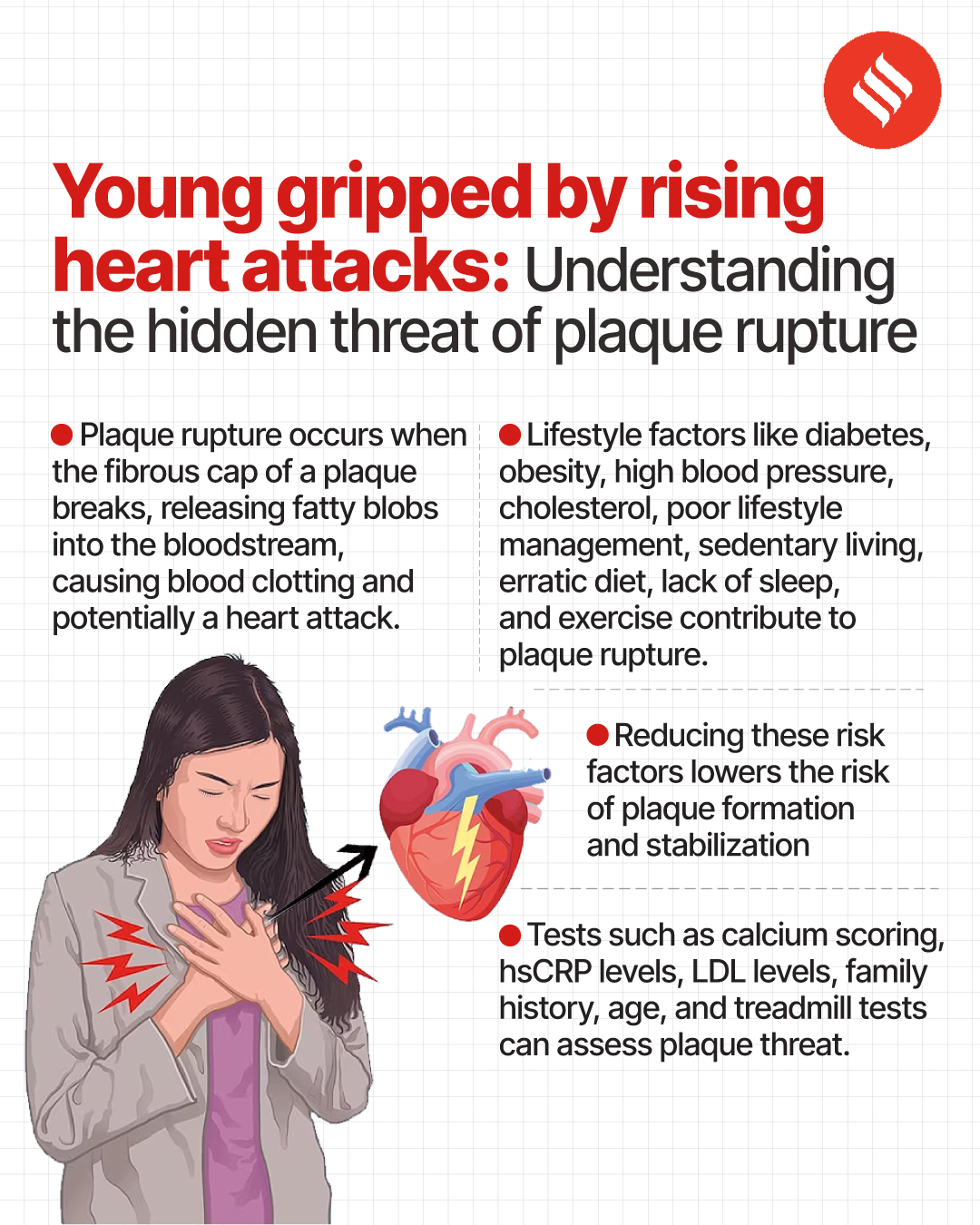Under-40 heart attacks: Understanding the hidden threat of plaque rupture
Even 20 to 30 per cent plaque deposits are less stable. They rupture or dislodge easily and this disruption means the body initiates blood clotting measures and releases platelets. A blood clot can form on top of that torn plaque and their combined obstructive force can trigger a heart attack, says Dr VK Bahl, Principal Director of Cardiac Sciences at Max Hospitals
 Why are relatively lesser plaques responsible for an increasing number of heart attacks that we see these days? (Source: Getty Images/Thinkstock)
Why are relatively lesser plaques responsible for an increasing number of heart attacks that we see these days? (Source: Getty Images/Thinkstock) Over the last 10 years, there has been a sharp rise in the number of young people suffering heart attacks. And such episodes happen earlier among Indians than the rest of the world population. Currently Indians suffer four times more heart attacks than Americans and 20 times more than the Japanese. And contrary to what people think — that only high-grade atherosclerosis or plaque formation in the walls of heart arteries by over 70 per cent trigger heart attacks — even 20 to 30 per cent plaques can pose a similar risk.
 What causes plaque rupture? (Designed by Abhishek Mitra)
What causes plaque rupture? (Designed by Abhishek Mitra)
Now how does that happen? Why are relatively lesser plaques responsible for an increasing number of heart attacks that we see these days? That’s because of a phenomenon called plaque rupture. Plaque, which begins as a soft and unstable deposit, becomes calcified and stable after years of gradual accumulation. In fact, the body’s protective mechanism can prevent a heart attack from stable plaques until they cross 70 per cent. Now the smaller, less stable deposits are not enough to restrict the flow of oxygenated blood, which is why you do not feel their impact on your heart. But they can cause a problem when they break apart. The thin fibrous cap on the plaque ruptures, releasing fatty blobs into the bloodstream. The body reacts to this disruption as unusual and an emergency. It immediately initiates blood clotting measures and releases platelets to seal what it perceives as a wound. A blood clot can form on top of that torn plaque and their combined obstructive force can affect the flow of oxygenated blood to the heart, triggering a heart attack.
So less severe blockages, which do not seem to be a threat when they hold good, become life-threatening when they are dislodged and blood cells clump around them to form bigger clots. This is borne out by data. A 2012 study by researchers in Denmark, which looked at survival rates in 4,711 women and 6,512 men after analysing the severity of blocked arteries through coronary angiography, found that people with less than 50 percent blockage of their heart’s arteries were at just about the same risk of death due to heart attack, stroke or heart failure (congestive heart disease) as people with a bigger plaque deposit in their arteries with a 50 per cent or greater blockage. Then a 2013 review from the UK collected angiography data from 41,960 patients, who were evaluated for suspected heart disease, and found that those with a non-obstructive heart disease accounted for an estimated third of people who visit their physician complaining of chest pain.
What causes plaque rupture? Of course, by now most Indians know the risk factors for heart disease — diabetes, obesity, high blood pressure, cholesterol, poor lifestyle management, sedentary living, erratic diet and lack of sleep and exercise. Sometimes, we top up these risk factors with additional stressors like smoking, over-worrying, overworking and over-indulging ourselves. At other times, we exhaust our body a bit too much by taxing it with our bad lifestyle choices and then subjecting it to the rigours of a gym routine without actually letting it rest or be prepared for a session. That’s what makes these lesser stable plaques prone to rupture. Once we reduce these aggravating factors, we reduce the risk of more plaque forming and stabilising those that exist.
How can this be done? This can be done by calculating your risk factor. If high risk, then your cardiologist will prescribe statins. At one time, they were just used as cholesterol-lowering drugs and were, therefore, only administered to those with high cholesterol. But by taking out the bad or low-density lipoprotein (LDL) out of the plaque, they also stabilise it. So, now we prescribe them to even those who may have lower cholesterol but score high on other risk factors of heart disease.
So how do you assess my plaque threat? Over the past week, most cardiologists have discussed a calcium scoring test, which is a non-invasive, simple CT scan that shows plaque deposits. Of course, it maps the older calcified plaque more accurately. A score above 100 is non-negotiable for statins. Then there’s the high-sensitivity C-reactive protein (hsCRP), a blood component indicator of inflammation. Higher levels of this marker mean you are more prone to heart attacks and strokes. An LDL level higher than 190 automatically qualifies you for statin use as does a family history of heart disease and an age category upwards of 40. Then there is the treadmill test or TMT to map heart stress. Often invasive tests may not work in unstable plaque and potential rupture scenarios because anyway they would not find significant arterial obstructions. Every diabetic should take a ten-year risk score. Of course, research is ongoing for more plaque-stabilising drugs and injectables but at the moment we have to measure high risk versus low risk categories for any kind of treatment protocol. But above all, Indians should begin lifestyle correction rather early.
(As told to Rinku Ghosh)
Photos





- 01
- 02
- 03
- 04
- 05


























